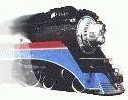Hi Jürgen und alle,
Zwischenbericht....
war grad bei meinem Händler und wollte sie abholen.
Erster Eindruck:
Optik: sehr schön - fast zu schön, so hat sie nicht mal in Allach ausgesehn (die knallweissen Griffstangen muss man irgendwie verwittern, wenn schon nicht die ganze Lok)
die SILBERNEN und stillstehenden Dachlüfter sind ein Fauxpas - da wäre m.M. nach besser, sie unauffälliger zu machen (im Betrieb warn sie sicher nach 14 Tagen schmutziggrau) , oder ganz wegzulassen.
Sound: dürfte passen, ich hab mir nicht die Mühe gemacht mit Originalaufnahmen zu vergleichen, aber wenn sie den Sound von der Originallok haben kann nicht viel falsch sein.
Lichtfunktionen: Grossteils ok, Pyle Lights, rotes Warnlicht, Numberboards, Classification Lights einzeln schaltbar. Super, mit dem hab ich nicht gerechnet.
Wie erwartet wieder der unsägliche fahrtrichtungsabhängige Lichtwechsel - scheinbar ist dieser Unfug so tief in der Szene verwurzelt, dass wir das nie wieder loswerden können. Wobei - wenn das das einzige Problem ist, werd ichs irgendwie schaffen das rauszuprogrammieren.
Nachdem mir der nette und bemühte Chef alles vorgeführt hat, und wir besagten Lichtwechsel getestet haben, war dann alles in der Schnauze der Lok dunkel. Reset, vom Gleis genommen, Zentrale abgeschalten - nix, tot.. Zweite Lok kontrolliert (.....mit Deutschbahn-Schleifer....) ... funktioniert. Decoder zwischen den beiden getauscht .... der wars nicht, "meine" nach wie vor dunkel.
Der Arme hat dann in Erwägung gezogen, das Light Board zu tauschen - hab dann aber angeregt, sie so wie sie ist zurückzuschicken, bevor sonst ev zwei defekte Loks übrigbleiben, mit denen es dann Probleme mit den Garantieanspruch gibt.
BIN ICH FROH DIE IM FACHGESCHÄFT BESTELLT ZU HABEN.... nicht auszudenken, wenn ich sie irgendwo über drei Ecken online , um 30 Euro billiger, besorgt hätte. Da hätt ich jetzt den Deppenspitz auf.
P.S. ich denke, die Option mit dem Funktionsdecoder kann ich vergessen... die diversen gedruckten Schaltungen sind so ausgeführt, dass man kaum etwas dran ändern oder adaptieren kann. Moderne Ingenieurskunst halt, so wie in jedem technischen Gerät heute, von der Kaffeemaschine bis zur Mondfähre.

